Abstract
In this study, we used machine learning (ML) to estimate time-lapse velocity variations in a reservoir region using seismic data. To accomplish this task, we needed an adequate training set that could map seismic data to velocity perturbation. We generated a synthetic seismic database by simulating reservoirs of varying velocities using a 2D velocity model typical of the Brazilian pre-salt ocean bottom node (OBN) acquisition, located in the Santos basin, Brazil. The largest velocity change in the injector well was around 3% of the empirical velocity model, which mimicked a realistic scenario. The acquisition geometry was formed by the geometry of 1 shot and 49 receivers. For each synthetic reservoir, the corresponding seismic data were obtained by estimating a one-shot forward-wave propagation using acoustic approximation. We studied the reservoir illumination to optimize the input data of the ML inversion. We split the set of synthetic reservoirs into two subsets: training (80%) and testing (20%) sets. We point out that the ML inversion was restricted to the reservoir zone, which means that it was inversion-oriented to a target. We obtained a good similarity between true and ML-inverted reservoir anomalies. The similarity diminished for a situation with non-repeatability noise.
1. Introduction
Time-lapse seismic is an important tool to unveil reservoir property changes due to oil/gas production [1]. Indeed, during the production life cycle of a reservoir, the displacement of water, oil, and gas in the reservoir changes the impedance properties of the rocks, which are reflected as differences in the seismic record from one survey to another [2]. In this context, the 4D, or time-lapse, seismic has been stated as an important tool to support the decision-making of oil/gas reservoir production. Moreover, in the current context of climate change [3], 4D seismic is also a tool to monitor and manage CO2 storage in geologic formations [4].
In this study, we explore a straightforward 4D seismic inversion methodology. In our method, we assume acoustic propagation, and we invert seismic data to obtain velocity models. To standardize the notation along the paper, we consider that we have seismic acquisition from a baseline reservoir and a subsequent, during production, monitor acquisition. To be precise, we use the time-lapse difference (monitor minus baseline) of seismic data to invert the velocity model perturbation (monitor minus baseline)—we call this anomaly the change or perturbation—in the reservoir region.
Target-oriented time-lapse inversion is a challenging task due to the complex physics relating the velocity changes in the reservoir to the seismic response [5]. In this context, a statistical inversion approach like the ML methodology seems to be appropriate to deal with uncertainty and lack of information. Some studies have proposed ML inversion techniques to produce velocity models directly from seismic data [6], but the huge amount of data limits the success of this endeavor. Several studies about 4D seismic and ML are focused on the preprocessing of seismic data to diminish non-repeatability noise [7,8] or to find the water velocity layer [9,10]. In time-lapse seismic research, some authors use seismic data and ML to estimate reservoir properties like water saturation or change in reservoir pressure [11,12,13]. These studies generally use not only seismic data as input but also well-log data, reservoir parameters, or physics rock parameters [14,15,16,17]. The novelty of this paper is the simplicity: we employ ML to perform a target-oriented velocity inversion using only pre-stack data. Moreover, our method is target-oriented, computationally economical, and needs low seismic data. In fact, we invert the reservoir anomalies using seismic data from a single shot.
We notice that the usual 4D inversion assumes a well-known baseline acquisition. In particular, the 4D target-oriented problem is focused on the inversion of a restricted reservoir region. Moreover, in the study area of our problem, the Brazilian pre-salt, the overburden issue caused by geomechanical movements above the target area is negligible. Therefore, the 4D target-oriented problem shares information with adjacent areas about the location of major geologic structures like horizontal layers or faults. In this restricted context of the 4D target-oriented problem, the ML inversion approach can be successful because several major issues of the geophysical inversion are minimized [1].
The seismic inversion based on one-shot acquisition is not feasible in standard 2D or 3D inversion problems. The reason for the unfeasibility of the one-shot inversion is due to the ambiguity in the location of the seismic events [18]. In fact, a seismic event caused by, for instance, a reflection in a layer interface does not present a well-defined position but rather can be localized at any point along an isochronous line centered in the seismic source [19]. In order to solve the ambiguity in the location of the seismic event, more shots are necessary. However, the location ambiguity is not a central issue in target-oriented 4D inversion once the overall layer positions are already well defined for the baseline acquisition [2]. In this context, we believe that the 4D target-oriented ML inversion proposed in this paper can surpass the limitation of the single-shot acquisition and become a fast and economical option in time-lapse inversion.
The outline of this study is as follows: in Section 2, we present the basics of the seismic model used in this study, the methodology to construct synthetic models used in the ML training, an illumination study, and the machine learning method for seismic inversion. In Section 3, we show the inversions performed using the ML technique for two cases without and with 4D noise. Finally, in Section 4 we present the main results, discuss the limitations of the method, and point out future perspectives.
2. Methodology
2.1. Synthetic Modeling
The proposed inversion methodology was tested and validated with synthetic seismic data. We used a realistic 20 km wide, 7.5 km deep P-wave velocity model (Figure 1) estimated from a pre-salt oil field (named Gato do Mato) located at the Santos basin, off a shore in Brazil [20,21]. The work of [22] provides more details about the geology of this area. Figure 1 also shows the acquisition geometry, formed of 1 shot and 49 ocean bottom nodes (OBNs). The source is located at an 8 m depth and at the center of the analysis region in the lateral direction, and the receivers are at a depth of 2 km with 400 m spacing. Also, the source wavelet is a Ricker with peak energy at 5 Hz frequency (15 Hz maximum bandwidth); this frequency range covers the basic frequency band employed in seismic exploration. The reservoir region is located at a depth of about 6 km, as indicated in Figure 1; the depth of the reservoir region is usual in a pre-salt formation.
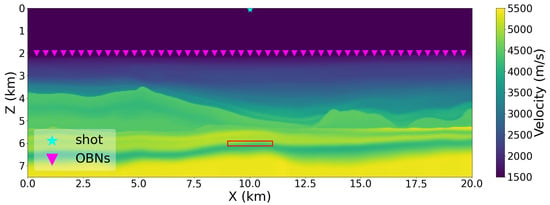
Figure 1.
P-wave velocity model and acquisition geometry used to model the synthetic database. The rectangle indicates the reservoir region.
The above parameters correspond to the baseline survey. We also considered 5000 monitor surveys, which differ from the baseline by the added velocity perturbations in the reservoir region to represent the time-lapse effect of production-induced fluid substitution. Different velocity perturbations were applied to the monitor surveys to simulate a number of possible fluid movements in the reservoir region due to oil and gas production. The velocity perturbations representing reservoir changes are described in more detail in Section 2.2.
The dataset is composed of 5001 shot gathers in total, one associated to the baseline and the others to each of the monitor surveys. The seismograms were obtained by calculating the finite differences’ approximation of the acoustic wave equation in 2D for constant-density and isotropic media. The main numerical parameters were a time step of 4 milliseconds, a total recording time of 10 s, and a regular grid spacing of 20 m. In addition, to avoid reflections at the borders, we used 25 convolutional perfectly matched layers (CPMLs) as the absorbing boundary condition added around the domain of analysis. Surface-related multiples were not modeled.
2.2. Reservoir Simulation
To test the inversion methodology, we produced a set of synthetic reservoir models based on the Gato do Mato model. The simulated injection well is located below the salt formation at a depth of 6000 m and in a horizontal position of 10,000 m. The region of the reservoir, the target region for inversion, is indicated with a red rectangle in Figure 1. Empirical data from the industry suggest that, for the Brazilian pre-salt, the maximal production-induced velocity perturbation in the reservoir is around 3%. In addition, the average dimension of the reservoir is 2000 m in the horizontal direction and 200 m in the vertical direction.
To perform an inversion task using ML, we needed an adequate training set, which, in our case, is a set of reservoir velocity models with a good variability in shape and velocity. In our algorithm, we considered the initial velocity model , as presented in Figure 1, and the reservoir velocity perturbation model that represents the changes in the reservoir due to oil and gas production. The perturbations in the reservoir are related to water, oil, or gas displacement in the media; all these factors induce changes in the physical properties of the rocks and consequent changes in acoustic velocity [2]. To model the reservoir anomaly, we employed a Gaussian statistical distribution centered around the injection well. The standard deviation of the Gaussian followed an aleatory distribution from 300 m to 500 m. The center of the Gaussian was sampled around the point .
2.3. Illumination Study
In order to assess whether the single-shot geometry would be able to extract information from the reservoir region, we conducted an illumination analysis. Ray tracing [23] is the conventional technique for illumination, but representing the wavefronts as rays is an approximation given the finite frequency of seismic signals. Instead, we performed the illumination analysis by migrating the “rabbit ear” component of the image condition of reverse-time migration (RTM). Higher migration magnitudes correspond to better illuminated regions of the subsurface.
We show in Figure 2 the illumination maps obtained by migrating different subsets of traces at a time. The target reservoir region is depicted in this figure by a rectangle. In Figure 2a, we depict the illumination that corresponds to traces 11–20, on the left side. In Figure 2b, we show the illumination corresponding to the five smallest offset traces (traces 22 to 27). Figure 2c corresponds to the illumination of traces 21 to 30, and Figure 2d to traces 31 to 40. We do not show the illumination corresponding to the far-offset traces 1 to 11 or 41 to 49, because these traces weakly contribute to illuminating the target area. The conclusion from these three panels is that the reservoir region is well illuminated by the employed single-shot acquisition geometry.
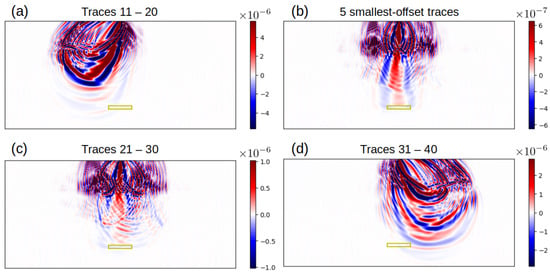
Figure 2.
Illumination map produced by a single seismic source. This color map should be interpreted as areas where the energy of the seismic wave pass by and is captured by the receptors: (a) traces of sequence numbers from 11 to 20 (inclusive), (b) the 5 smallest offset traces, (c) traces from 21 to 30, and (d) traces from 31 to 40. The yellow rectangle indicates the target reservoir region as in Figure 1. The illumination map reveals that this simple acquisition geometry provides reasonable information to invert the target region.
2.4. Machine Learning Training and Testing
As mentioned in Section 2.1, we simulated a database of 5000 synthetic anomalies in total. These data were randomly split into disjoint 80% train 20% test so that 4000 anomalies could be used for training the network and 1000 for testing.
In this work, we train a machine learning algorithm to invert the time-lapse difference of P-wave velocity in the reservoir region from the time-lapse difference of pre-stack seismic data. The proposed ML inversion methodology is illustrated in Figure 3. First, we calculated the differences of all monitor pre-stack seismograms relative to the baseline seismogram. Then, we extracted (crop) from each time-lapse seismic difference the subset of data within the time interval that contains most of the energy reflected from the reservoir. To avoid biasing the algorithm by the specific amplitude range of seismic data—which depends on factors unrelated to the reservoir such as source wavelet amplitude and distances between source and receivers—we normalize each cropped difference by its maximum magnitude, resulting in the normalized time-cropped seismic data . Regarding the velocity model, the preprocessing steps are used to calculate the time-lapse velocity differences and extract the subset within the 220 m high and 2020 m wide reservoir region, resulting in the velocity anomaly in the target region. Finally, and are, respectively, passed as inputs and desired outputs (targets) for the supervised training of a neural network.
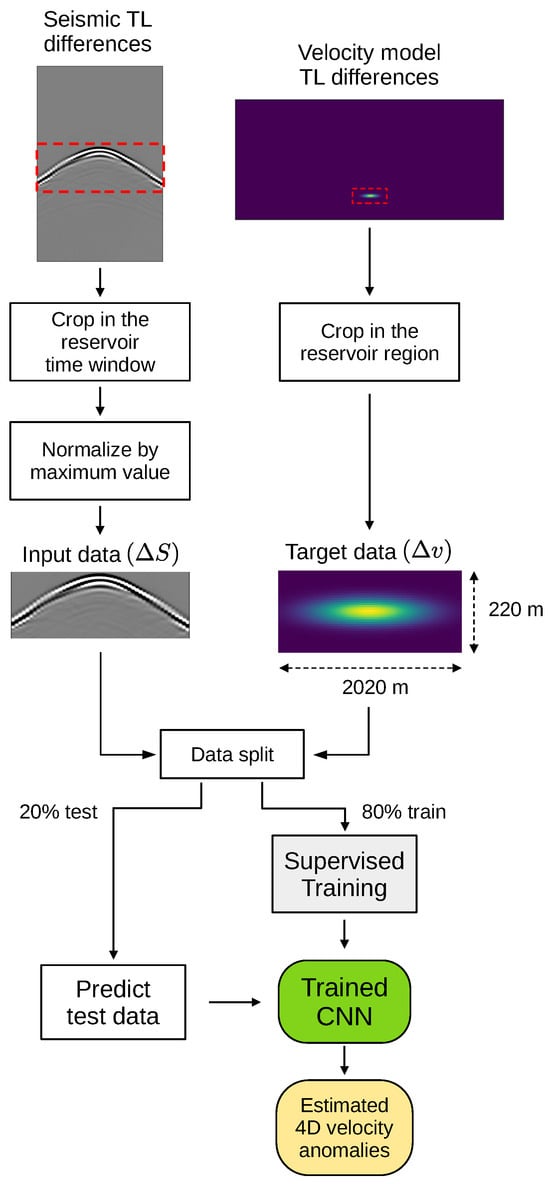
Figure 3.
Block diagram of the proposed ML inversion methodology. The input set consists of the seismic time-lapse (TL) difference and the output consists of the inverted reservoir anomaly. The red dashed rectangles indicate the subsets of time-lapse differences considered to calculate input and target data: we extract from seismic differences the time window concentrating most of the reflection energy coming from the reservoir, and from the velocity differences we consider the spatial region of the reservoir.
The core of the inversion methodology is formed by the neural network shown in Figure 4. The network has a novel architecture, inspired by the temporal convolutional network (TCN) [24]. The first step is to disregard from the large-offset traces 1 to 7 and 42 to 49, because the illumination study (Section 2.3) revealed that those traces carry little reflection information from the reservoir region; keeping them could induce the network to learn spurious input–output associations. The remaining traces pass through a sequence of five convolutional layers arranged in a novel way. Recall that the standard convolutional layer applies a sliding 2D kernel to inputs that are neighboring to each other (unit dilation) in both dimensions. The layers we use apply the sliding 2D kernel to neighboring inputs in the horizontal axis, and further apart from each other in the vertical axis across layers. In other words, the convolutional layers use unit dilation in the space dimension, and exponentially increasing dilations in the time dimension. This way, we capture longer duration time relationships between seismic samples and spatially localized relationships across traces. The values of kernel size and dilation increasing rate were chosen such that each element at the output of the fifth layer is a function of all input elements (full history coverage). A series of convolutional layers with increasing dilations is at the core of the TCN architecture, widely used for sequence modeling; the difference here is that we combine this concept with the standard convolutions across traces. The next layer is a global max pooling layer that retains only the maximum value of each feature map outputted by the convolutional layers in order to reduce dimensionality and constrain the neural network complexity. With this pooling, only the strongest patterns make it through the rest of the network, and it also introduces some invariance to subtle changes in the input [25], resulting in better generalization capabilities. The pooling outputs are submitted to a dropout layer with a 2% rate, and then to a fully connected layer of 1111 neurons. The next layer then applies a linear shifting and scaling to the 0–100 range, which is the interval of variation in the anomaly velocities. By performing this, we force the data in the previous layers to be within the [−1, 1] interval for a better conditioning of the error gradient during backpropagation, increasing the stability and convergence of training. Finally, the data are reshaped as an 11 × 101 matrix to form the predicted velocity anomaly . The proposed network architecture has parameters of about . For training, we use Adam optimizer with the mean squared error (MSE) loss function, an adaptively decreasing learning rate (starts at , reduces by 80% whenever validation loss does not improve for 25 consecutive epochs), batch size 32, and early stopping as the training stopping criterion. Dropout and early stopping are regularization measures to reduce the overfitting issue [25,26]. Figure 5 shows the MSE loss curves computed for the training and the validation sets. The loss function indicated in the figure shows a good convergence during the neural network training and validation processes. The curves for the training and validation subsets are very close to one another, an evidence that the training converged and that the network was not overfitting.
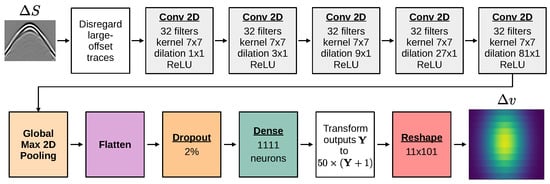
Figure 4.
Proposed neural network architecture. The input of the ML is the seismic time-lapse difference within the reservoir time window and the output is the velocity anomaly of the target region.
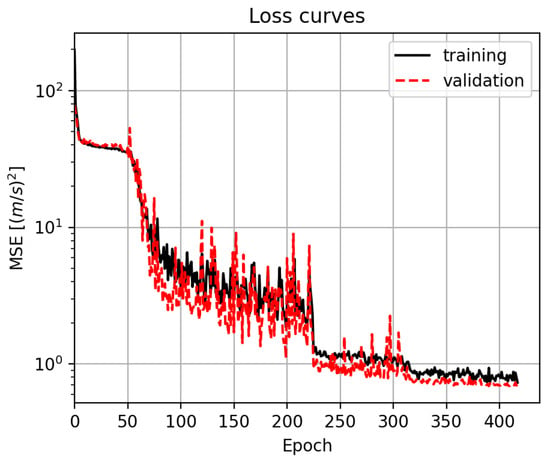
Figure 5.
Loss curves computed on the training and validation subsets during the training of the neural network employed for velocity inversion. The loss function is calculated with velocities in the scale of the 4D anomalies (0–100 m/s range).
To compare the accuracy of the inverted velocity reservoir anomaly with the true anomaly, we employ the Structural Similarity Index Measure (SSIM) [27], which is a scalar metric that quantifies the perceptual similarity between images. SSIM varies in the [0, 1] range; 1 indicates that the compared images have good similarity, and 0 means that they are very different. In addition, we employ a mean average error (MAE) to quantify uncertainty in our analysis. The MAE estimates the pixel-to-pixel difference between the ML-estimated velocity anomaly and the real anomaly.
3. Results
3.1. Inversion for Perfect Repeatability
The ML target-oriented inversion methodology is tested in the synthetic dataset introduced in Section 2.1. Initially, we tested the ML method in noise-free data. The test was performed for the 1000 test samples, which corresponds to 20% of the total of 5000 samples. The obtained values of the SSIM index for the testing inversions are inside the interval , which is an excellent result for image reproducibility. Moreover, the outcomes of the ML method are illustrated in the first columns of Figure 6 in which we compare true and predicted images for five cases according to SSIM criteria. The illustrated examples are located at key percentiles of the SSIM distribution on the test set: minimum (worst case), the three quartiles, and maximum (best case).
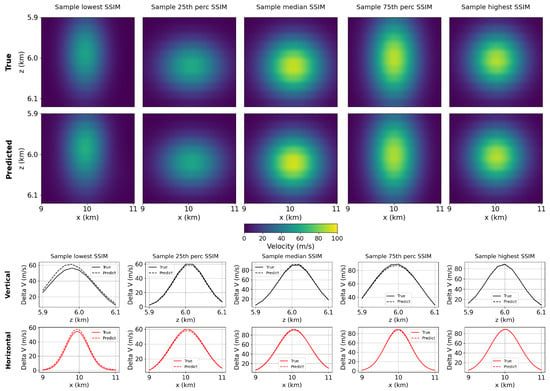
Figure 6.
Inversion results of individual samples for the perfect repeatability scenario. The yellow pattern in the panels represent the velocity anomaly, the horizontal and vertical dimensions reproduce the reservoir region indicated in the rectangle of Figure 1. Comparison of true (first row) and inverted (second row) reservoir anomaly for five samples at key points of the SSIM distribution on the test subset: minimum (worst case), 25th percentile, median, 75th percentile, and maximum (best case). The last two rows compare, respectively, the central vertical and central horizontal velocity profiles of the velocity anomalies.
A more detailed view of the reservoir anomaly is depicted in the last two rows of Figure 6, which shows the central vertical and central horizontal velocity profiles. We notice in these figures a very good agreement between true and predicted velocity profiles for the noiseless case. Indeed, even in the worst scenario, the predicted profiles are very close to the true profiles. As we shall see in Section 3.2, the predicted anomalies are impacted by non-repeatability noise.
3.2. Inversion in Non-Repeatability Scenarios
The ML inversion methodology developed in this paper was designed to work on a perfect repeatability scenario. The ML inversion input is the seismic data difference, which in practice is contaminated by non-repeatability effects. In the industry, data non-repeatability is treated using several techniques such as 4D binning [2], matched filtering [28,29], amplitude balancing [30] and time warping [31]. However, the complete removal of non-repeatability effects is impracticable. In this way, we test our methodology in this more challenging scenario in which some treatment to erase 4D noise was implemented, but a residual non-repeatability effect is still present. We model such a non-repeatability residual by introducing uniform-distributed random perturbations to the positions of receivers in the lateral direction. The new data-testing set was created similarly to the synthetic seismic data presented in Section 2.1, whereby the difference is the aleatory shaking in the receiver position. We employ two non-repeatability noises according to the maximal aleatory variation in the receiver position: ±0.1 mand ±0.5 m.
The testing of the ML inversion methodology with non-repeatability noise is shown in Figure 7 and Figure 8 for maximum receiver variation equal to ±0.1 m and ±0.5 m, respectively. The basic schema of these two figures repeats the previous Figure 6 that shows the inversion for the ideal case of perfect repeatability. The two upper rows show the true and the predicted velocity anomaly according to key percentiles of the SSIM distribution on the dataset: minimum (worst case), median case, maximum (best case), and two intermediary quartiles. The two lower rows of these Figures show the central vertical and central horizontal velocity profiles of the velocity anomalies. The medians of the estimated SSIM index of ML inversion are 0.69 and 0.48 for the ±0.1 m and ±0.5 m cases, respectively. The Kruskal–Wallis test for the SSIM shows significant difference among the three scenarios ( = 2082, df = 2, p-value < 0.00001). An analysis of the MAE reveals the same pattern of the SSIM quantifier. The median of MAE corresponding to the noiseless case is 0.38, while to the noisy case, the medians are 230 and 550 for the ±0.1 m and ±0.5 m cases, respectively. The Kruskal–Wallis test for the MAE also reveals significant difference among the three treatments ( = 2144.9, df = 2, p-value < 0.00001).
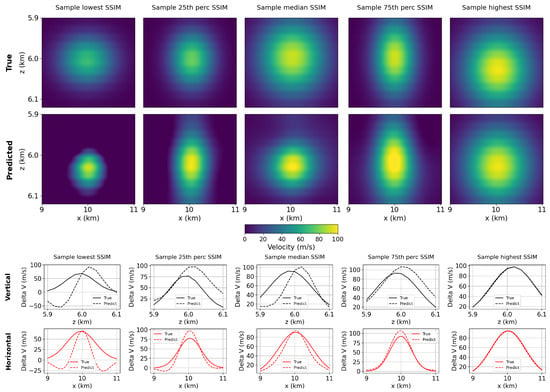
Figure 7.
Inversion results of individual samples for a scenario with non-repeatability, modeled by randomly moving the receivers in the lateral directions, with maximum perturbations equal to ±0.1 m. The yellow pattern in the panels represent the velocity anomaly; the horizontal and vertical dimensions reproduce the reservoir region indicated by the rectangle in Figure 1. Comparison of true (first row) and predicted (second row) time-lapse velocity anomalies in the target region for specific samples of a test dataset contaminated with geometry non-repeatability noise. The 4D noise was modeled by randomly shifting the receivers in the lateral direction, with maximum perturbations equal to ±0.1 m. The shown samples are located at key percentiles of the SSIM distribution on the referred dataset: minimum (worst case), three quartiles, and maximum (best case). The last two rows compare, respectively, the central vertical and central horizontal velocity profiles of the velocity anomalies.
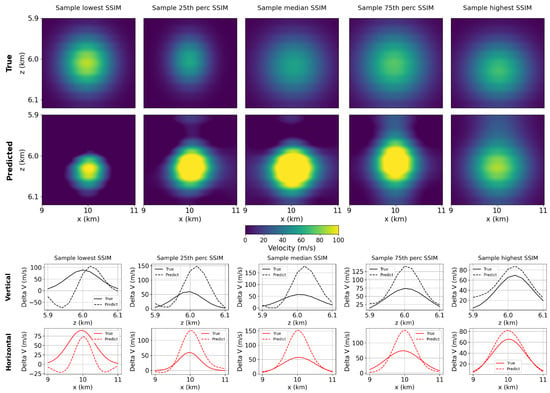
Figure 8.
Inversion results of individual samples for a scenario with non-repeatability, modeled by randomly moving the receivers in the lateral directions, with maximum perturbations equal to ±0.5 m. The yellow pattern in the panels represent the velocity anomaly; the horizontal and vertical dimensions reproduce the reservoir region indicated by the rectangle in Figure 1. Comparison of true (first row) and predicted (second row) time-lapse velocity anomalies in the target region for specific samples of a testing dataset contaminated with geometry non-repeatability noise. The illustrated samples are located at key percentiles of the SSIM distribution on the referred dataset: minimum (worst case), three quartiles, and maximum (best case). The last two rows compare, respectively, the central vertical and central horizontal velocity profiles of the velocity anomalies.
The general overview of Figure 6, Figure 7 and Figure 8 reveals that non-repeatability noise degrades inversion performance, as expected. The worsening of the ML methodology is observed by visual inspection of the velocity anomalies of the mentioned figures. In addition, the velocity profiles, both vertical and horizontal, are also affected by the non-repeatability noise. The difference between the true and predicted velocity profiles of Figure 6 contrasts with profiles of Figure 7 and, particularly, Figure 8, which has a strong noise. In the horizontal direction, the peak of the anomaly is centered at 10 km and this position is not perturbed by noise. However, in the vertical direction, the peak shifts from 6 km to 6.04 in the worst scenario. In this way, the non-repeatability noise produces a shift depth in the peak of the anomaly.
In order to quantify the uncertainty of the inversion methodology, we compute the error in the prediction of the velocity anomaly. Figure 9 estimates the pixel-to-pixel difference between ML-predicted and true velocity anomalies. Indeed, Figure 9 is an error color map where the horizontal and vertical axes reproduce the same dimensions of the previous Figure 6, Figure 7 and Figure 8. The first panel in Figure 9 shows the error for the perfect repeatability case, while Figure 9b,c for the repeatability noise cases corresponding to ±0.1m and ±0.5 m, respectively. The error magnitude is much larger in the noise scenarios, the error bars in the panels are not in the same scale. The general pattern with and without noise is distinct, the noiseless case is characterized by an underestimation in the peak of the anomaly, while the noisy cases are characterized by an overestimation in this peak and an underestimation in the region above the anomaly. This information is important for the geophysical interpreter that in the field case will deal with a noisy environment. In this situation, the interpreter should consider that the anomaly peak, whose velocity anomaly is produced by a fluid replacement, could be overestimated.
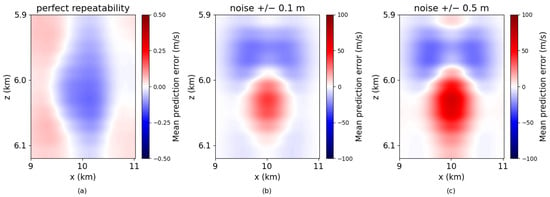
Figure 9.
Spatial distribution of prediction errors for the test scenarios with (a) perfect repeatability, (b) ±0.1 m geometry 4D noise, and (c) ±0.5 m geometry 4D noise.
4. Conclusions
The 4D seismic inversion encompasses a myriad of different techniques [1,32]. In this work, we present an option for methodological simplicity, instead of introducing rock physics, production features, or detailed reservoir characterization [11,33]. We employ seismic data produced from an acoustic wave and invert the reservoir velocity using just one shot and dozens of receivers.
The results are satisfactory when we consider the low computational cost and the economical use of input seismic data. The computational time for training and testing the 5000 samples used in this paper was around 4 h at a center for high-performance computing at our university (NPAD/UFRN). In the same computing facility, a similar 4D inversion [20] took one hundred hours to perform a similar inversion using full-waveform inversion (FWI) methodology. The high computational cost of FWI is related to a substantial degree of memory usage, and the wave propagation is associated with one iteration in the optimization procedure that uses data from a hundred seismic shots. Moreover, we emphasize that in our inversion effort, we employed a single shot, which in part explains the comparative low computational cost. Indeed, a usual seismic inversion can use a hundred shots to provide good illumination to perform an acceptable inversion.
We point out an important limitation of our methodology: the diversity and quality of the training dataset. The success of the ML inversion is strongly dependent on the quality of the training dataset. In fact, in a field case, if the actual velocity anomaly significantly differed from the anomalies presented in the training dataset, the inversion would not be successful. In this way, a successful application of our methodology in a field case would depend on a good simulation of the reservoir changes over time, which entails reservoir simulations with the production of ample scenarios.
The present study comprises a simple target-oriented ML inversion methodology based on one-shot acquisition geometry and a novel neural network architecture. In future work, we intend to expand our methodology in several directions, for instance, to introduce more shots in the acquisition geometry for each survey to test the method with greater illumination in the reservoir region. Another open line of research is to improve the ML training with seismic data contaminated by non-repeatability noise. We stress that in our methodology, we initially suppose that we can erase the non-repeatability noise, but we are aware that in practical situations, this is impossible. In this way, we tested the methodology with a residual non-repeatability noise and the results are acceptable. To conclude, we present in this paper an ML method to perform a 4D seismic inversion that has low computational complexity when compared with traditional FWI inversion.
Author Contributions
Conceptualization, G.C.; Methodology, R.C.F.A.; Software, R.C.F.A., M.M.G. and T.B.; Validation, S.X.-d.-S.; Formal analysis, M.M.G., T.B. and G.C.; Investigation, K.R. and T.B.; Resources, J.M.d.A.; Data curation, J.M.d.A.; Writing—original draft, G.C.; Writing—review & editing, R.C.F.A.; Visualization, K.R.; Funding acquisition, S.X.-d.-S. and J.M.d.A. All authors have read and agreed to the published version of the manuscript.
Funding
This research was funded by Shell Brazil through the “New computationally scalable methodologies for target-oriented 4D seismic in pre-salt reservoirs” R&D project. Additional funding was provided by the CNPq Brazilian research Agency, under grants 307907/2019-8 and 311589/2021-9.
Data Availability Statement
The modeled seismic data supporting the conclusions of this study will be made available by the authors on razonable request.
Acknowledgments
The authors gratefully acknowledge Shell Brazil for financial support, and the Brazilian National Agency for Petroleum, Natural Gas and Biofuels (ANP) for the R&D levy regulation. We also acknowledge NPAD/UFRN for providing the supercomputing resources used in this research.
Conflicts of Interest
The authors declare no conflict of interest.
References
- Johnston, D.H. Practical Applications of Time-Lapse Seismic Data; Society of Exploration Geophysicists: Tulsa, OK, USA, 2013. [Google Scholar] [CrossRef]
- Nguyen, P.K.T.; Nam, M.J.; Park, C. A review on time-lapse seismic data processing and interpretation. Geosci. J. 2015, 19, 375–392. [Google Scholar] [CrossRef]
- Mac Dowell, N.; Fennell, P.; Shah, N.; Maitland, G. The role of CO2 capture and utilization in mitigating climate change. Nat. Clim. Change 2017, 7, 243–249. [Google Scholar] [CrossRef]
- Aldakheel, M.; Pevzner, R.; Gurevich, B.; Glubokovskikh, S. Seismic characterization of CO2 storage driven by time-lapse images of a prior injection using the artificial neural network. Interpretation 2021, 9, T911–T925. [Google Scholar] [CrossRef]
- Cao, J.; Roy, B. Time-lapse reservoir property change estimation from seismic using machine learning. Lead. Edge 2017, 36, 234–238. [Google Scholar] [CrossRef]
- Zhang, S.B.; Si, H.J.; Wu, X.M.; Yan, S.S. A comparison of deep learning methods for seismic impedance inversion. Pet. Sci. 2022, 19, 1019–1030. [Google Scholar] [CrossRef]
- Alali, A.; Kazei, V.; Sun, B.; Alkhalifah, T. Time-lapse data matching using a recurrent neural network approach. Geophysics 2022, 87, V405–V417. [Google Scholar] [CrossRef]
- Alali, A.; Smith, R.; Nivlet, P.; Bakulin, A.; Alkhalifah, T. Time-lapse seismic cross-equalization using temporal convolutional networks. In Proceedings of the SEG/AAPG/SEPM First International Meeting for Applied Geoscience & Energy, Denver, CO, USA, 26 September–1 October 2021; pp. 1440–1444. [Google Scholar] [CrossRef]
- Duan, Y.; Yuan, S.; Hatchell, P.; Vila, J.; Wang, K. Estimation of time-lapse timeshifts using machine learning. In SEG Technical Program Expanded Abstracts 2020; Society of Exploration Geophysicists: Houston, TX, USA, 2020; pp. 3724–3728. [Google Scholar] [CrossRef]
- Araújo, R.C.F.; Corso, G.; Nascimento, H.A.D.; Souza, S.X.; Araújo, J.M.; Barros, T. Estimation of Water Velocity and Receiver Position Changes in Time-Lapse Seismic Using Machine Learning. Braz. J. Geophys. 2024, 42, 1–12. [Google Scholar] [CrossRef]
- Rollmann, K.; Soriano-Vargas, A.; Almeida, F.; Davolio, A.; Schiozer, D.J.; Rocha, A. Convolutional Neural Network Formulation to Compare 4-D Seismic and Reservoir Simulation Models. IEEE Trans. Syst. Man Cybern. Syst. 2022, 52, 3052–3065. [Google Scholar] [CrossRef]
- Xue, Y.; Araujo, M.; Lopez, J.; Wang, K.; Kumar, G. Machine learning to reduce cycle time for time-lapse seismic data assimilation into reservoir management. Interpretation 2019, 7, SE123–SE130. [Google Scholar] [CrossRef]
- Kaur, H.; Zhong, Z.; Sun, A.; Fomel, S. Time-lapse seismic data inversion for estimating reservoir parameters using deep learning. Interpretation 2022, 10, T167–T179. [Google Scholar] [CrossRef]
- Dramsch, J.S.; Christensen, A.N.; MacBeth, C.; Lüthje, M. Deep Unsupervised 4-D Seismic 3-D Time-Shift Estimation With Convolutional Neural Networks. IEEE Trans. Geosci. Remote Sens. 2022, 60, 1–16. [Google Scholar] [CrossRef]
- Corte, G.; MacBeth, C. A Physics-Based Loss Function to Constrain Neural Network Inversion of 4D Seismic Data. In Proceedings of the 82nd EAGE Annual Conference & Exhibition, Amsterdam, The Netherlands, 18–21 October 2021; European Association of Geoscientists & Engineers: Utrecht, The Netherlands, 2021; Volume 2021, pp. 1–5. [Google Scholar] [CrossRef]
- Li, Y.; Alkhalifah, T.; Guo, Q. Target-oriented time-lapse waveform inversion using deep learning-assisted regularization. Geophysics 2021, 86, R485–R495. [Google Scholar] [CrossRef]
- Kim, S.; Park, J.; Seol, S.; Byun, J. Machine Learning-Based Time-Lapse 1d Seismic Full-Waveform Inversion with Efficient Training Data Generation in a Carbon Capture and Storage Monitoring. Geoenergy Sci. Eng. 2023, 238, 212852. [Google Scholar] [CrossRef]
- Yilmaz, O. Seismic Data Analysis: Processing, Inversion, and Interpretation of Seismic Data; Society of Exploration Geophysicists: Tulsa, OK, USA, 2001. [Google Scholar]
- Wang, Y. Seismic Inversion: Theory and Applications; Wiley Blackwell: Hoboken, NJ, USA, 2016. [Google Scholar] [CrossRef]
- da Silva, D.; Duarte, E.F.; Almeida, W.; Ferreira, M.; Moura, F.A.; de Araújo, J.M. Target-oriented inversion using the patched Green’s function method. Geophysics 2021, 86, R811–R823. [Google Scholar] [CrossRef]
- Lopez, J.; Neto, F.; Cabrera, M.; Cooke, S.; Grandi, S.; Roehl, D. Refraction seismic for pre-salt reservoir characterization and monitoring. In SEG Technical Program Expanded Abstracts 2020; Society of Exploration Geophysicists: Houston, TX, USA, 2020; pp. 2365–2369. [Google Scholar] [CrossRef]
- Cypriano, L.; Yu, Z.; Ferreira, D.; Huard, B.; Pereira, R.; Jouno, F.; Khalil, A.; Urasaki, E.; Cruz, N.; Yin, A.; et al. OBN for pre-salt imaging and reservoir monitoring—Potential and road ahead. In Proceedings of the 16th International Congress of the Brazilian Geophysical Society, Rio de Janeiro, Brazil, 19–22 August 2019; Volume 318. [Google Scholar]
- Wang, Y. Seismic ray tracing in anisotropic media: A modified Newton algorithm for solving highly nonlinear systems. Geophysics 2014, 79, T1–T7. [Google Scholar] [CrossRef]
- Bai, S.; Kolter, J.Z.; Koltun, V. An Empirical Evaluation of Generic Convolutional and Recurrent Networks for Sequence Modeling. arXiv 2018, arXiv:1803.01271v2. [Google Scholar] [CrossRef]
- Géron, A. Hands-on Machine Learning with Scikit-Learn, Keras & TensorFlow, 3rd ed.; O’Reilly Media: Sebastopol, CA, USA, 2022. [Google Scholar]
- Bishop, C.M. Neural Networks for Pattern Recognition; Oxford University Press: New York, NY, USA, 1995. [Google Scholar]
- Wang, Z.; Bovik, A.; Sheikh, H.; Simoncelli, E. Image quality assessment: From error visibility to structural similarity. IEEE Trans. Image Process. 2004, 13, 600–612. [Google Scholar] [CrossRef] [PubMed]
- Rickett, J.E.; Lumley, D.E. Cross-equalization data processing for time-lapse seismic reservoir monitoring: A case study from the Gulf of Mexico. Geophysics 2001, 66, 1015–1025. [Google Scholar] [CrossRef]
- Lumley, D.; Adams, D.C.; Meadows, M.; Cole, S.; Wright, R. 4D seismic data processing issues and examples. In SEG Technical Program Expanded Abstracts 2003; Society of Exploration Geophysicists: Houston, TX, USA, 2003; pp. 1394–1397. [Google Scholar] [CrossRef]
- Rickett, J.; Lumley, D.E. A cross-equalization processing flow for off-the-shelf 4D seismic data. In SEG Technical Program Expanded Abstracts 1998; Society of Exploration Geophysicists: Houston, TX, USA, 1998; pp. 16–19. [Google Scholar] [CrossRef]
- Hale, D. Dynamic warping of seismic images. Geophysics 2013, 78, S105–S115. [Google Scholar] [CrossRef]
- Corte, G.; Dramsch, J.; Amini, H.; MacBeth, C. Keynote 5: Informing neural networks with fluid flow consistent property correlations: A 4D seismic inversion application. In Third EAGE Workshop on Practical Reservoir Monitoring; European Association of Geoscientists & Engineers: Utrecht, The Netherlands, 2021; Volume 2021, pp. 1–5. [Google Scholar] [CrossRef]
- Dramsch, J.; Corte, G.; Amini, H.; Lüthje, M.; MacBeth, C. Deep Learning Application for 4D Pressure Saturation Inversion Compared to Bayesian Inversion on North Sea Data. In Proceedings of the Second EAGE Workshop Practical Reservoir Monitoring 2019, Amsterdam, The Netherlands, 1–4 April 2019; pp. 1–5. [Google Scholar] [CrossRef]
Disclaimer/Publisher’s Note: The statements, opinions and data contained in all publications are solely those of the individual author(s) and contributor(s) and not of MDPI and/or the editor(s). MDPI and/or the editor(s) disclaim responsibility for any injury to people or property resulting from any ideas, methods, instructions or products referred to in the content. |
© 2024 by the authors. Licensee MDPI, Basel, Switzerland. This article is an open access article distributed under the terms and conditions of the Creative Commons Attribution (CC BY) license (https://creativecommons.org/licenses/by/4.0/).